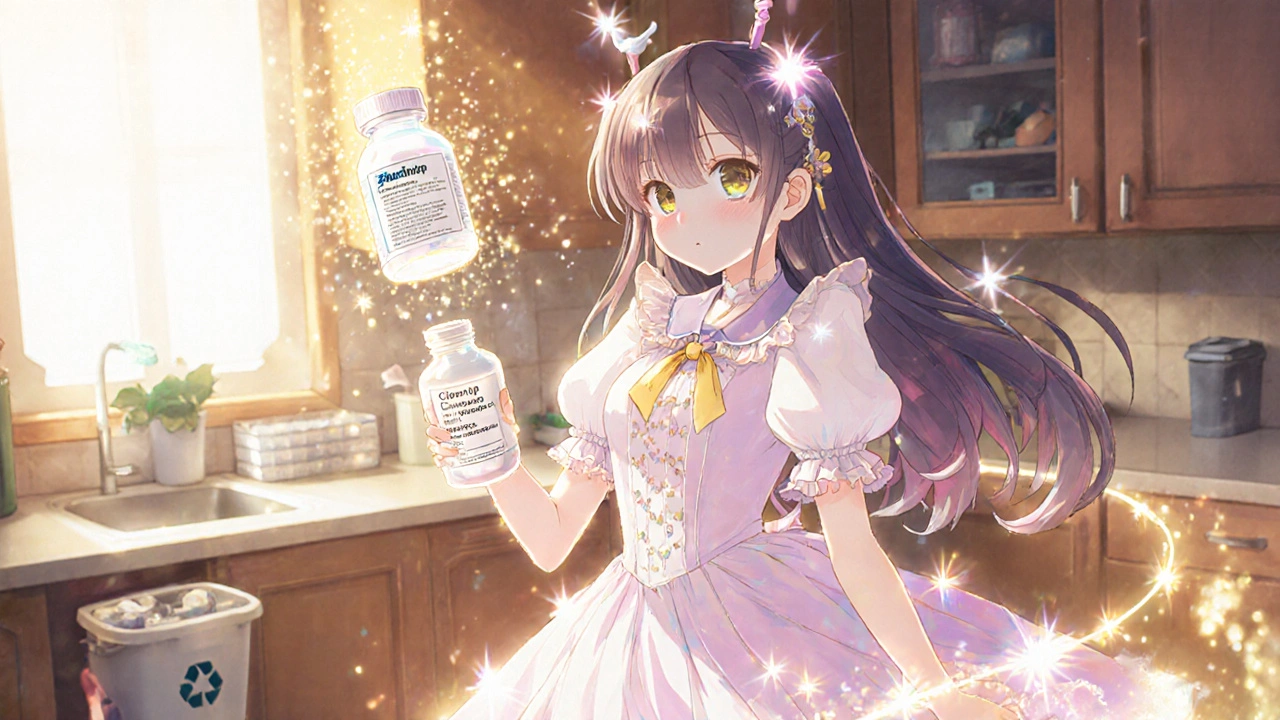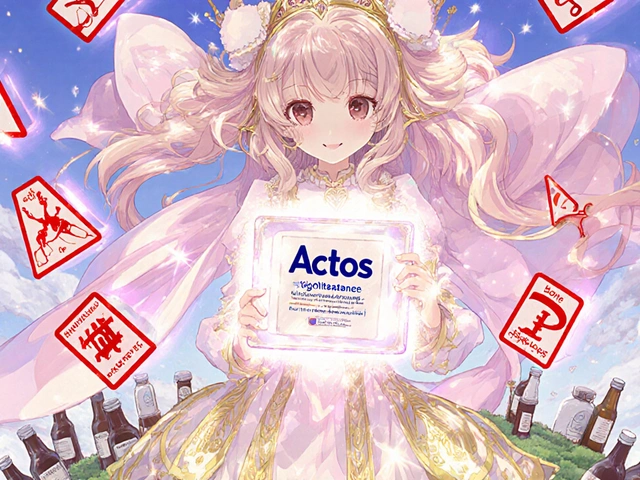Every year, over a million people in the U.S. become victims of identity theft linked to discarded prescription bottles. It’s not just a scary statistic-it’s something that happens to real people who never thought their empty pill containers could be used against them. Your name, your doctor’s name, your condition, your prescription number-all printed clearly on a label that gets tossed in the trash. Criminals don’t need to hack a database. They just need to dig through your recycling bin.
If you’ve ever wondered why you should bother removing that label before throwing out a medicine bottle, here’s the truth: personal information on medication bottles is one of the easiest ways for fraudsters to steal your identity. The Federal Trade Commission lists prescription labels as one of the top five sources for medical identity theft. In 2021 alone, over 412,000 cases were reported in the U.S. tied to this exact issue. And it’s not just about stealing drugs-it’s about opening credit accounts, filing fake insurance claims, or even getting medical treatment under your name.
Why Simply Tossing the Bottle Isn’t Enough
You might think, "I’ll just peel the label off." That’s what most people do. But modern prescription bottles don’t use regular paper labels. They use waterproof, acrylic-adhesive labels made from polypropylene-designed to survive moisture, heat, and rough handling. When you try to peel them off by hand, you’re not removing the label. You’re leaving behind sticky residue that still contains every letter of your name, your birth date, and your diagnosis.
Titan Labs tested 500 bottles using manual peeling. In 92% of cases, the adhesive residue still held readable personal data. Even if you scrape it off with a knife, you risk scratching the plastic and making the remaining ink harder to remove. And if you’re thinking about soaking it in water or vinegar? That fails 78% of the time. The adhesive is built to resist exactly those household tricks.
What about using a black marker? It seems simple. Cover the text with a Sharpie. But here’s the catch: digital recovery tools can still pull out the original text. In a 2021 Javelin Strategy study, 41% of "blacked-out" labels yielded recoverable data when scanned with smartphone apps. Even under infrared light, ghost images of your name and prescription number often remain visible. The FTC itself says marker obscuration is "acceptable if removal fails," but only because it’s better than doing nothing-not because it’s safe.
The Three Proven Methods to Destroy Your Data
There are three reliable ways to make sure your personal data is gone for good. Each has pros and cons. Choose based on whether you plan to reuse the bottle or just throw it away.
1. Chemical Dissolution (Best for Reusing Bottles)
If you want to keep the bottle-for vitamins, supplements, travel pills, or even craft projects-this is your best option. A solvent called Cleanup Solvent-22, developed by Titan Labs, breaks down the adhesive bond in 15-20 seconds. You spray or dab it on the label, wait a moment, then peel. The label comes off cleanly. No sticky residue. No ink left behind. It works on HDPE and polypropylene bottles, which make up 85% of all prescription containers in the U.S.
Independent testing showed a 98.7% success rate across hundreds of bottles. The process takes less than a minute. You can buy it online for around $15. It’s affordable-less than 1% of the average monthly prescription cost. But there’s a catch: it has a strong chemical smell. Use it in a well-ventilated area. Don’t use it near open flames. And never use it on glass bottles-it’s only meant for plastic.
Many users who repurpose bottles for organizing pills or sewing kits say this method saved their projects. One Reddit user wrote: "I reuse my old pill bottles as travel containers. Before, I couldn’t get the labels off without ruining them. Now, they look brand new."
2. Permanent Marker Obscuration (Best for Quick Disposal)
If you don’t have solvent or don’t plan to reuse the bottle, use a black permanent marker. But don’t just scribble over it. You need to apply three thick, overlapping layers to fully cover every word. CHOC (Children’s Hospital of Orange County) tested this method and found it takes about 47 seconds per bottle to do it right.
After marking, hold the bottle up to a bright light. If you can still see any letters, even faintly, go over it again. This isn’t optional. A single visible digit or letter can be enough for fraudsters to piece together your identity. Don’t assume your handwriting is enough. Use a fine-tip Sharpie or similar permanent marker. Ballpoint pens? Forget it. They’ll smear and leave readable traces.
This method isn’t perfect, but it’s better than nothing. The FTC acknowledges it as a fallback when removal isn’t possible. Just remember: it’s not secure. It’s a temporary fix.
3. Physical Shredding (Best for Final Disposal)
If you’re done with the bottle for good, shredding is the most foolproof method. But not with your home paper shredder. Prescription bottles are too thick and rigid. You need a heavy-duty cross-cut shredder designed for plastic. Services like LegalShred.com offer this as a specialty service-they’ll take your empty bottles, shred them, and ensure zero data recovery.
For most people, this isn’t practical. But if you have a lot of bottles-say, from managing medications for an elderly parent-consider a local medical waste disposal service. Some pharmacies now offer in-store drop-off bins with built-in label removal tools. CVS and Walgreens have had these since 2020. Just ask at the counter. They’ll remove the label for you before taking the bottle.

What to Do With the Bottle After
Once your data is gone, what happens next? That depends on your goal.
- If you’re reusing: Wash the bottle with warm soapy water, let it dry, and use it for vitamins, supplements, or small items like screws or beads. Some people even turn them into travel-sized lotion containers or first-aid kits.
- If you’re throwing it away: Put the empty bottle in your regular trash. Do not recycle it unless your local program accepts #2 or #5 plastic and confirms labels are fully removed. Most recycling centers reject bottles with any trace of adhesive or ink.
- If you’re disposing of the medicine too: Mix the pills with kitty litter, coffee grounds, or dirt. Put them in a sealed plastic bag before tossing. This makes them unappealing to pets or people who might go through the trash. Never flush them unless the label says to.
Timing Matters
Don’t wait. The longer you leave a labeled bottle in your home, the higher the risk. CHOC’s research shows that identity theft risk increases by 40% if you delay label removal beyond 24 hours after the medication is finished. That’s not a guess. That’s data from Javelin Strategy’s 2021 report.
Make it part of your routine. When you finish a prescription, take five minutes to remove the label. Do it before you put the bottle in the cabinet. Make it as automatic as rinsing a coffee cup. You wouldn’t leave your credit card receipt on the counter. Don’t leave your medical identity exposed on the shelf.

What’s Changing in the Industry
Pharmacies are starting to take this seriously. More than 70% of U.S. children’s hospitals now use CHOC’s label-removal protocol. Drug manufacturers are testing new inks that fade after 30 days. McKesson is piloting RFID-enabled bottles that auto-delete data once the prescription is filled.
But until those become standard, the responsibility is yours. The DEA, FTC, and HIPAA don’t require you to do this-but they all agree you should. And with healthcare identity theft costing victims an average of $1,347 per incident, it’s one of the cheapest security steps you’ll ever take.
Quick Checklist: Your 5-Minute Prescription Label Cleanup
- Finish your medication? Don’t wait.
- Check the bottle material (plastic? #2 or #5?).
- If reusing: Apply Cleanup Solvent-22, wait 20 seconds, peel.
- If trashing: Cover label with three thick layers of black permanent marker.
- Hold to light. If any text shows through, repeat.
- Dispose of medicine safely (mix with coffee grounds or kitty litter).
- Throw bottle in trash-not recycling.
It takes less time than checking your phone. But it could save you thousands.






Comments
Shannon Hale
November 17, 2025 AT 07:11 AMOh my GOD, I can’t believe people still just toss these bottles like they’re trash bags. You’re basically handing identity thieves a VIP pass to your medical records. I’ve seen this happen to my aunt-fake prescriptions, $20k in debt, cops involved. It’s not ‘scary,’ it’s a crime waiting to happen. And no, Sharpie doesn’t cut it. I’ve tested it. Ghost text pops up under UV light like it’s mocking you. Use the damn solvent. It’s $15. Your future self will thank you-or sue you.
Holli Yancey
November 18, 2025 AT 03:48 AMI never realized how much risk was in something so small. I’ve been peeling labels off and feeling guilty about the residue ever since I read this. I think I’ll start keeping a small container in my bathroom just for empty pill bottles until I can properly dispose of them. Maybe I’ll even try the solvent-just to feel a little more in control. Thanks for the wake-up call.
Gordon Mcdonough
November 18, 2025 AT 17:23 PMWTF is this? Some tech bro’s scam to sell Cleanup Solvent-22?? Who even is Titan Labs? I’ve been peeling labels since 2008 and I’m still here. You think criminals are gonna dig through my trash? They got better things to do than play detective with my blood pressure meds. And why the hell do you care if someone knows I take Zoloft? I’m not ashamed. This is fear porn wrapped in a lab coat. Stop selling fear. Start living. Also dont use sharpie it dont work lol
Jessica Healey
November 19, 2025 AT 03:29 AMgordon u are so wrong. i just got done cleaning out my mom’s meds after she passed and let me tell u-some of those labels were STILL readable after 3 years in the garage. i used a razor blade and vinegar and it was like a horror movie. i cried. i was so mad. we gotta do better. i’m buying that solvent tomorrow. no excuses. also i used a sharpie once and my dog licked the bottle. i don’t even wanna think about what could’ve happened.
Levi Hobbs
November 19, 2025 AT 05:15 AMInteresting breakdown-I especially appreciate the breakdown of methods by use case. I’ve been using the marker method, but I never realized I needed three layers. I’ve been doing one or two, thinking it was enough. I’ll definitely be more thorough going forward. Also, I didn’t know CVS and Walgreens had drop-off bins. I’ll ask next time I’m in. Small changes, big impact. Thanks for the practical advice.
henry mariono
November 20, 2025 AT 19:33 PMI’ve been quietly doing the solvent method for years. It’s not glamorous, but it works. I don’t post about it because I don’t want to sound like I’m preaching. But I’m glad someone finally laid it out clearly. For those who think it’s overkill-imagine if someone used your name to get opioid prescriptions. That’s not hypothetical. It’s happening right now. Just do the five minutes. You’ll sleep better.
Sridhar Suvarna
November 21, 2025 AT 10:41 AMThis is critical. In India, we have no such awareness. People throw bottles with names and diagnoses in open bins. Elderly are targeted. I will translate this into Hindi and share in my community. Safety is not a luxury. It is basic dignity.
Joseph Peel
November 22, 2025 AT 23:38 PMShannon, your tone is unnecessarily aggressive. The data here is valuable, but the fearmongering undermines credibility. The FTC’s stance on marker use is precisely that it’s a fallback-not a failure. Your anecdote about your aunt is tragic, but it’s not a universal truth. We should empower people with options, not shame them for not buying a $15 chemical. This isn’t about paranoia. It’s about practical risk mitigation. The solvent is great. But so is the marker-if done properly. Let’s keep the conversation grounded.